SPECIAL
E-mon Guide
The Secret of Japanese Hospitality
@ BONSAI LABO Rin

2021.05.07


Written by: TK(TK)
Originally made its way from China, the art of Bonsai has evolved into its own form in Japan through its long history. In recent years, Bonsai has become more accessible, and many enjoy miniature Bonsai trees like Mame Bonsai trees whether they live in a house with no yard or at a small apartment in Tokyo. Praised as the “Living Art,” Bonsai is attracting attention around the world. Following its introduction to the world at Japan World Exposition in 1970, the art of Japanese Bonsai became an international sensation and, by 2016, the export of Bonsai exceeded 8 billion yen. Today, the World Bonsai Convention is held every four years around the world including the United States, Germany, and South Korea. It’s safe to say Bonsai has become a global trend.
BONSAI LABO Rin in the matsuyamachi neighborhood in Osaka’s Chuo Ward is a great place to explore such world of Bonsai. Shall we?
BONSAI LABO Rin: Osaka’s Bonsai Specialty Shop
BONSAI LABO Rin can be found in Osaka’s Matsuyamachi, affectionately called “Matchamachi” by the locals. It’s a quick 1-minute walk from Osaka Metro’s Matsuyamachi Station.
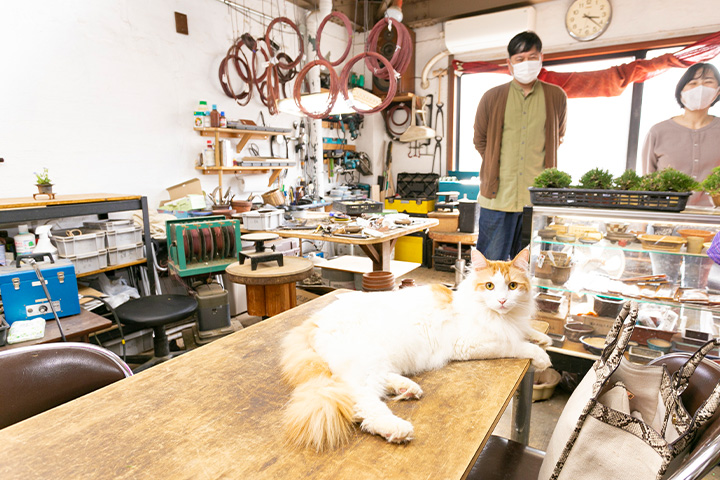
We were welcomed by the owner Miyazato-san, his wife, and their poster cat, Rex. The Labo is Miyazato-san’s studio that also serves as a school to provide workshops and a store to sell Bonsai pots and stands.

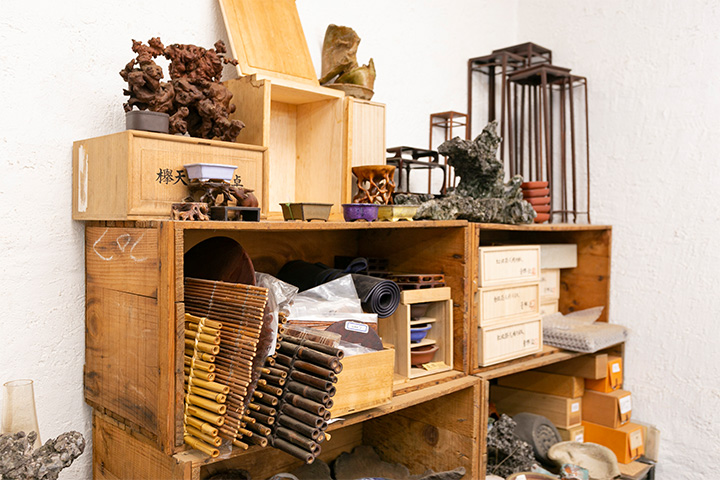
What is BONSAI?
We first looked at a small pine tree, Kuromatsu (Japanese Black Pine), synonymous for pine bonsai.

Both bonsai trees below are Kuromatsu, but one is 20 years old while the other is 40 to 50 years old. Half a century of life is packed in this tiny tree!
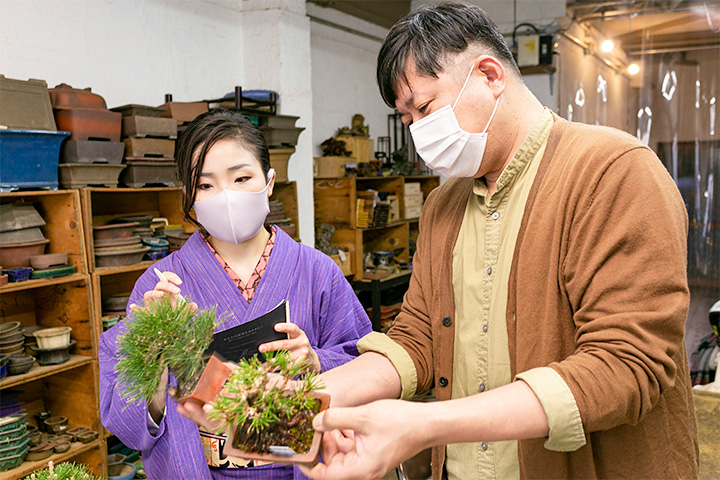
According to Miyazato-san, “Bonsai trees are small and difficult to grow. We start with a small pot that fits perfectly and, when the roots grow into the pot, we repot the tree into a slightly larger pot. We continue repotting as the tree grows.”
I saw some wiring on the branches. Wouldn’t it break the branches??
“This is called training. We wrap the wire around the branches to style the tree into an ideal shape. Pine trees won’t break when bent as they contain pine resin that makes the branches flexible. We also adjust the length of leaves (Mekiri) and cut off old, unnecessary leaves (Furuhatori) as part of maintenance once a year,” says Miyazato-san.
The value of a Bonsai tree depends a lot on its age. Then, how do you tell how old a Bonsai tree is?
The easiest is to check Mikihada trunk surface. While the young trees have a smooth surface, long years add layers of barks to the tree, which crack to create its unique solemn character. According to Miyazato-san, older Bonsai trees have a calming presence in their branches and leaves.

The Art of Japanese Hospitality
The rooftop of BONSAI LABO Rin is a sight to see. It’s lined with a wide variety of Bonsai trees—large or small, highly valuable to easily accessible (at a few thousand yen) even for beginners.


Customers from all over the world used to visit Rin before the pandemic hit, and Miyazato-san’s Instagram has many followers abroad. I’m curious what attracts the international fans to Bonsai.
Miyazato-san: “Bonsai enthusiasts first and foremost appreciate the Japanese spirituality it represents. Bonsai is something you display for someone. For example, have you seen a Bonsai tree displayed in the tokonoma (an alcove in a traditional Japanese room) of a historic temple or at a luxury hotel? I believe these displays are at the heart of hospitality, indicative of the host’s thoughtfulness for the guests.”

I began to understand how a Bonsai tree creates harmony between the space and the natural scenery and how I can enjoy the art of Bonsai. I was ready to ask Miyazato-san what he sees in Bonsai.
Miyazato-san: “Ultimately, it’s about creating ‘naturalness’—to grow a Bonsai tree that has a beautiful design while it does not look like anyone has touched it. I think spending a lot of time and providing lots of care is how Bonsai enthusiasts enjoy creating natural beauty.”
Some masterpiece Bonsai trees are well over 100 years old, requiring care across multiple generations. In other words, the more Bonsai fans and enthusiasts there are, the more great Bonsai trees we’ll have.
Photographer Turned Bonsai Expert
All Bonsai trees at BONSAI LABO Rin are grown as merchandise…except for one. It’s this ivy. There is a story behind this precious 80-year-old ivy.
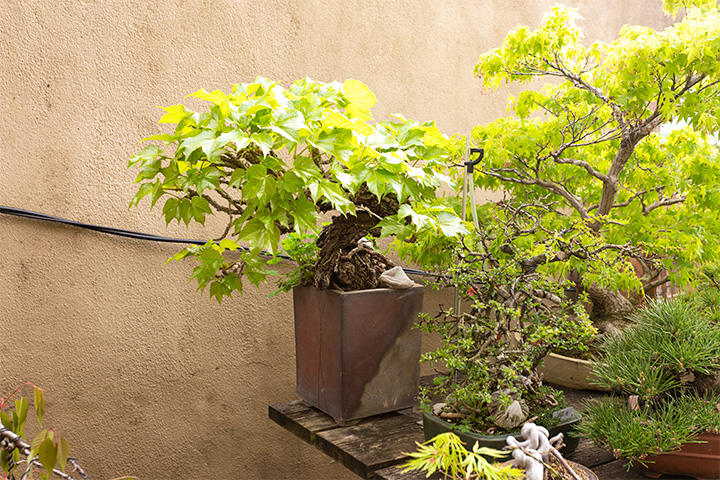
Miyazaki-san was a photographer before he founded BONSAI LABO Rin. He loved the manual work to create each piece of photography and used to spend hours in the dark room when he was a student. Digitization progressed in the world of photography after graduation and, as he became unsure of his career, he came across Bonsai.
Miyazaki-san: “A Bonsai display at a teashop in my neighborhood caught my eye. The master of the shop gave me a ticket to a Bonsai exhibit where it all began. I still remember the intensity I felt.“
He kept in touch with the teashop master through the training and opening of the shop, and, about 5 or 6 years ago, was given this ivy. The teashop master—who’s over 80 years old—got it from his father when he was a child. The tree was as big as a pinky then.
Miyazaki-san: “The aesthetics of this Bonsai is beautiful but, more than that, this Bonsai is full of memories and sentiments. I feel I’m only holding it for him for the time being—there is no way I can sell this.”
Each Bonsai has its own story and sentiments that are carried over from a person to another when it crosses hands. The story doesn’t end when Bonsai is purchased; it actually begins.
Starting a Life with Bonsai
My interests in Bonsai grew as I learned about Bonsai. It was time for me to find my own Bonsai!
Rin carries Bonsai trees as well as Shitakusa (literally “undergrass”) called Kusamono (glassy plants) used as an accent plant. The idea is a scenery is complete when you have a combination of a tree and Shitakusa, which also serves to accentuate the size of the tree in contrast.
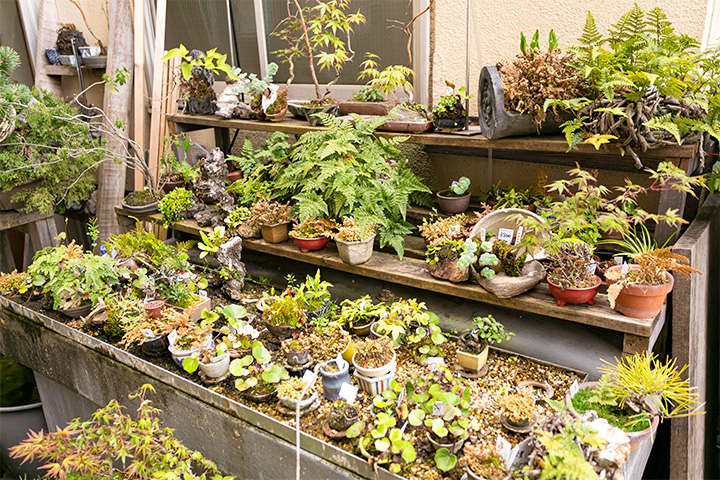
I was interested in a Bonsai that changes through seasons and bears flowers and fruits. I first looked at a Japanese maple tree. You can enjoy the red leaves with a Japanese Maple Bonsai just like you would with Japanese Maple trees, but I was told it’s actually very difficult to produce the beautiful red.

Miyazato-san: “Maple trees need lots of sunlight during summer in order to produce the bright red color. You also need to water often to keep it hydrated because dryness is its biggest enemy.”
I thought of a watering can when I heard this. Alternatively, you can immerse the entire pot in a larger pot. At home, a plastic bucket would do the job. I didn’t realize how much water was needed. In order to grow a good Bonsai, water as well as fertilizer and weeding are important, and so is listening to the plant to understand what it needs, they say.
These cute miniature Bonsai with round moss are Pyrrosia hastata (Felt fern) and Woodsia macrochlaena. You’ve got to make sure you pull the weeds and old grass as the plant grows. Here, I’m holding a tiny world in my hands.
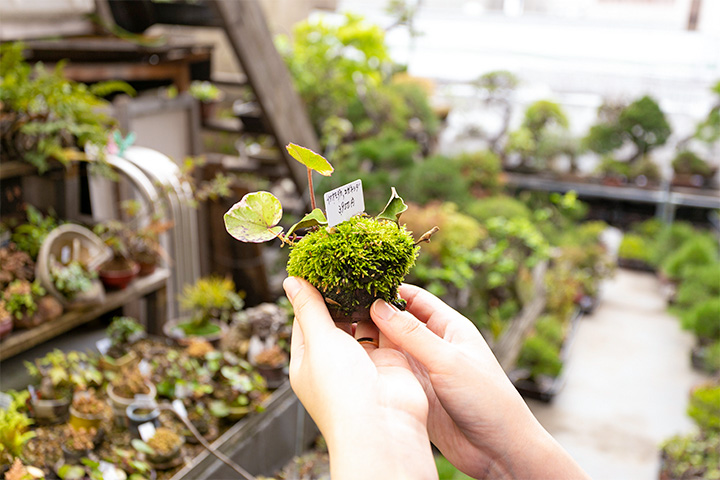
In the end, I chose Crimson Glory Vine (Vitis coignetiae). I liked the thick moss at the bottom of the tree and the tall and slender branches and leaves. I can’t wait to see how the leaves thicken and the fruit grows on this.

The last lessen I learned from Miyazato-san was how to display Bonsai—it’s his belief that Bonsai is to be displayed as part of hospitality. The basics of the Bonsai display include a combination of a Bonsai tree and Shitakusa accent plant, Bonsai stand, and a scroll. The scroll below depicts a hazy moon, creating a perfect scene for early April, when I purchased my first Bonsai at Rin.
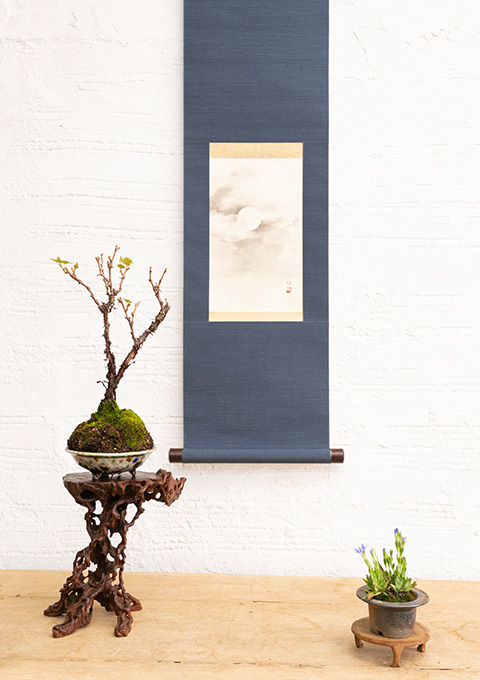
Bonsai is more than just growing a living thing and enjoying its artistic elements. It is also about the depth that comes with its formation over generations and the art of hospitality that takes it beyond a self-absorbed hobby. Perhaps, Bonsai represents a time in which one indulges in doing something for someone and connecting with that person.
BONSAI LABO Rin is a perfect place to start a life with Bonsai.
Check out the beauty of Bonsai on Miyazato-san’s Instagram, too!
@bonsai_labo_rin_osaka_japan
Spots Introduced
BONSAI LABO Rin
[Access] Moved to Tanba City, Hyogo Prefecture.
[Hours] Under renovation
[Closed] Open every day
Recommended Plans
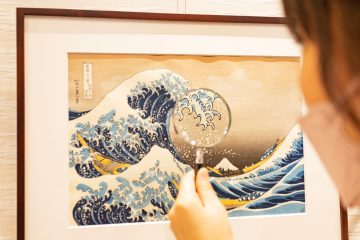
The World of Ukiyo-e:
Japonism that Captured the World
In 17th to 19th century Japan, after the turbulent and violent Warring States period ended, …
2025.06.27

A Must See Summer Festival in Osaka:
The Fantastical Tenjin Matsuri
with Mikoshi, Boats, and Fireworks
The Tenjin Matsuri (Tenjin Matsuri Festival) is one of the biggest festivals in …
2025.06.06

Off-The-Beaten-Track:
A Historic Walk in Tennoji
Many come to Osaka to enjoy food and shopping, but Osaka is also a city with a …
2025.05.30






